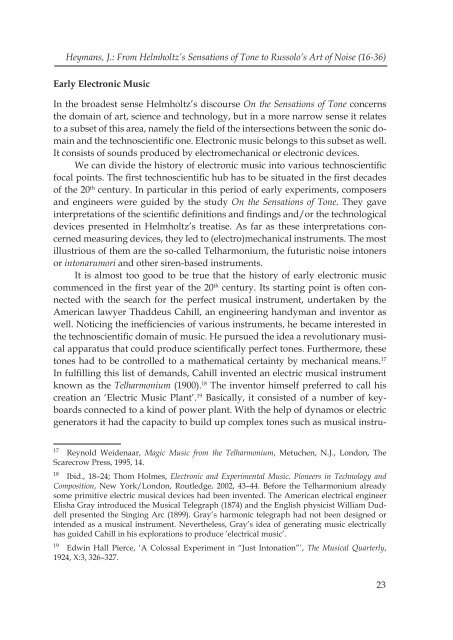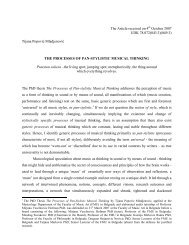John Heymans1 FROM HELMHOLTZ'S SENSATIONS ... - New Sound
John Heymans1 FROM HELMHOLTZ'S SENSATIONS ... - New Sound
John Heymans1 FROM HELMHOLTZ'S SENSATIONS ... - New Sound
Create successful ePaper yourself
Turn your PDF publications into a flip-book with our unique Google optimized e-Paper software.
Heymans, J.: From Helmholtz’s Sensations of Tone to Russolo’s Art of Noise (16-36)<br />
Early Electronic Music<br />
In the broadest sense Helmholtz’s discourse On the Sensations of Tone concerns<br />
the domain of art, science and technology, but in a more narrow sense it relates<br />
to a subset of this area, namely the fi eld of the intersections between the sonic domain<br />
and the technoscientifi c one. Electronic music belongs to this subset as well.<br />
It consists of sounds produced by electromechanical or electronic devices.<br />
We can divide the history of electronic music into various technoscientifi c<br />
focal points. The fi rst technoscientifi c hub has to be situated in the fi rst decades<br />
of the 20 th century. In particular in this period of early experiments, composers<br />
and engineers were guided by the study On the Sensations of Tone. They gave<br />
interpretations of the scientifi c defi nitions and fi ndings and/or the technological<br />
devices presented in Helmholtz’s treatise. As far as these interpretations concerned<br />
measuring devices, they led to (electro)mechanical instruments. The most<br />
illustrious of them are the so-called Telharmonium, the futuristic noise intoners<br />
or intonarumori and other siren-based instruments.<br />
It is almost too good to be true that the history of early electronic music<br />
commenced in the fi rst year of the 20 th century. Its starting point is often connected<br />
with the search for the perfect musical instrument, undertaken by the<br />
American lawyer Thaddeus Cahill, an engineering handyman and inventor as<br />
well. Noticing the ineffi ciencies of various instruments, he became interested in<br />
the technoscientifi c domain of music. He pursued the idea a revolutionary musical<br />
apparatus that could produce scientifi cally perfect tones. Furthermore, these<br />
tones had to be controlled to a mathematical certainty by mechanical means. 17<br />
In fulfi lling this list of demands, Cahill invented an electric musical instrument<br />
known as the Telharmonium (1900). 18 The inventor himself preferred to call his<br />
creation an ‘Electric Music Plant’. 19 Basically, it consisted of a number of keyboards<br />
connected to a kind of power plant. With the help of dynamos or electric<br />
generators it had the capacity to build up complex tones such as musical instru-<br />
17 Reynold Weidenaar, Magic Music from the Telharmonium, Metuchen, N.J., London, The<br />
Scarecrow Press, 1995, 14.<br />
18 Ibid., 18–24; Thom Holmes, Electronic and Experimental Music. Pioneers in Technology and<br />
Composition, <strong>New</strong> York/London, Routledge, 2002, 43–44. Before the Telharmonium already<br />
some primitive electric musical devices had been invented. The American electrical engineer<br />
Elisha Gray introduced the Musical Telegraph (1874) and the English physicist William Duddell<br />
presented the Singing Arc (1899). Gray’s harmonic telegraph had not been designed or<br />
intended as a musical instrument. Nevertheless, Gray’s idea of generating music electrically<br />
has guided Cahill in his explorations to produce ‘electrical music’.<br />
19 Edwin Hall Pierce, ‘A Colossal Experiment in “Just Intonation”’, The Musical Quarterly,<br />
1924, X:3, 326–327.<br />
23



